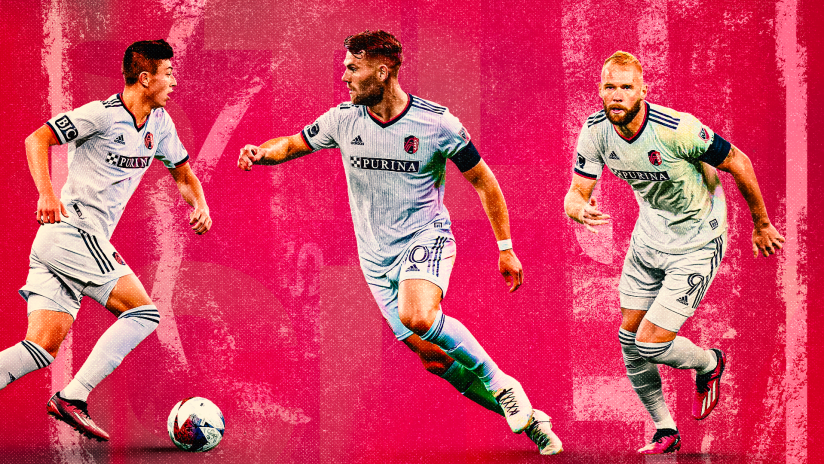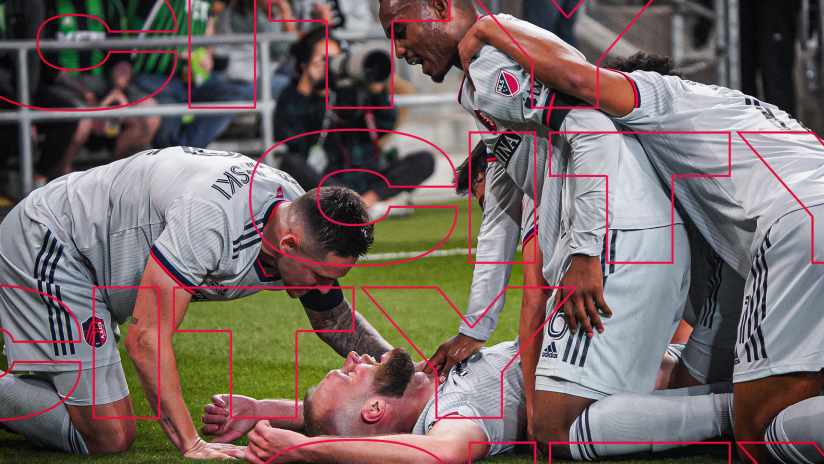St. Louis can rightly boast of being into soccer before soccer was considered cool by the North American mainstream – way, way, way before.
Like, say, the 1950 World Cup, when five St. Louisans started for the US men’s national team in their shock 1-0 victory over England – widely regarded as the greatest upset in sports history. Or the 1980s, when indoor soccer’s St. Louis Steamers were a hot ticket, outdrawing the NHL’s Blues in attendance for four consecutive years even as the hockey team routinely contended for the Stanley Cup.
Or you could measure it by the steady stream of professionals and internationals churned out by the region’s rich soccer landscape over the decades. From the likes of Taylor Twellman, Steve Ralston and Vedad Ibišević to current standouts like Tim Ream, Josh Sargent, Will Bruin and Joe Willis – and rising talents like Miguel Perez, the St. Louis CITY SC homegrown who made his MLS debut at age 17 in the club’s first-ever match last weekend – the area has produced players not just in volume, but those with cultured technique and high soccer IQ.
“The excitement, the understanding, the knowledge and the passion here, even pre-MLS, I would say is probably even higher than in a lot of MLS markets, to be totally honest,” native son Brad Davis, a USMNTer, six-time MLS All-Star and two-time MLS Cup winner with the Houston Dynamo who returned to St. Louis in 2020 to lead respected youth club Scott Gallagher SC, where he himself played as a child, told MLSsoccer.com.
“The tradition is deep-rooted here in St. Louis, the history is deep-rooted here.”
Soccer City USA
All this and more makes Saturday’s inaugural home match against Charlotte FC (8:30 pm ET | MLS Season Pass) at CITYPARK, their gorgeous new downtown stadium, an iconic moment not just for the club or the city, but an even deeper culture, lovingly passed down from generation to generation for over a century.
Take Mike Sorber, a top performer on the USMNT’s 1994 World Cup squad whose father Pete coached juco powerhouse Florissant Valley Community College for 30 years, winning 10 national championships and nurturing dozens of future pros. Both are members of the St. Louis Soccer Hall of Fame.
“I have a dad that's 93 years old, so he was a big part of that culture, and his dad took him to games at Carondelet Park or Fairgrounds Park where there could be, I don't know, 3,000, 4,000, 5,000 people, but standing – there weren't stands, you were just standing\] three or four or five deep,” recalled Mike, who now coaches at [Toronto FC, the latest stop in a two-decade coaching career across four MLS clubs and the national team.
“The community, the immigrants who came to St. Louis, it was a soccer and a baseball town. I grew up hearing the stories, and I grew up interacting with the Harry Keoughs and the Bob Keoughs and the Pat McBrides and the Al Trosts. And so I was immersed in the game.”
The sport has long been dyed into the fabric of everyday life in and around St. Louis in a manner more commonly found in the traditional hotbeds of Europe and South America.
“I was fortunate enough to grow up in a soccer town where, whether it was club ball or high school, there was a lot of attention put on youth sport,” said FC Cincinnati head coach Pat Noonan this week. “We had a lot of big names in the youth soccer landscape that had come from our town. So there’s a lot of pride in that city with the players that have come out of there, the coaches that have come out of there, the success that has come out of there.”
Sargent’s parents met as adolescents playing in the church-based soccer leagues that rank as some of the oldest such competitions in the United States, as did Sorber and his wife Mindy. Players grew up competing alongside one another from grade school to college, and thanks to the 10-time NCAA Division I national champion men's soccer program at St. Louis University, you didn’t even have to leave the city limits to test yourself at the latter level.
“I played high-school soccer with Josh's dad, Jeff. My wife played college soccer with his mom. So talk about a small community,” said Sorber, who also coached Davis at SLU. “The big thing in St. Louis is, you played in your parish, so you had all the little Catholic grade schools, and you competed against each other. So that was the start.
“Then when you played club soccer, there was a north-south rivalry that was built in. You had the club teams in the north, the club teams in the south and you’d compete against each other. The two biggies, so to speak, were Scott Gallagher in the north, Busch Soccer Club in the south. And so that would be a big rivalry for the most part locally, then getting out of your state, the regional and then national championships, which we also won.”
24/7 soccer culture
Nashville SC goalkeeper Willis grew up in St. Louis, with a backstory that underlines the game’s ubiquity there. Two of his uncles played competitively, one of whom made it all the way to the Chicago Sting of the NASL and MISL, and made sure Joe had a soccer ball at his feet from the moment he could walk. He recalls watching Brad Davis play high-school ball as an awestruck kid, and himself later starred for the same program, Chaminade Prep, one of several schools involved in ferocious local showdowns.
“This was before academy took off and became what it is now,” said Willis. “Those high-school soccer games were getting a few thousand people, at least, per game. Not just family and friends, but just soccer fans in the city coming to watch high school kids play, and I think the level was really high.
“When I was probably 8 to 10 years old, maybe a little bit older, I would go with my family to watch high-school soccer games and seeing those guys, they felt almost like superheroes, or like they were professionals in that sense.”
Twellman, who’s been one of St. Louis soccer’s most prominent evangelists as a broadcaster, had similar experiences in his own soccer-centric family.
“The high-school competition and rivalries is legit,” he told MLSsoccer.com. “Like, the sections of the city – North side hates South side, the East side’s all of a sudden up and coming, they're developing players, there's a lot of that.”
That ‘24/7 soccer culture’ that is so often perceived by pundits to be elusive in the US and Canada? It’s been an everyday thing in the Gateway City for as long as anyone can remember.
“We didn't take it for granted,” Davis said. “I mean, there were times where we were trying to find every high school possible, every patch of grass possible, we had no place to go. We were practicing anywhere, everywhere. We were bringing our own lawnmowers to cut the grass. No, truthfully! That’s really part of the mentality.
“We've never forgotten who the pioneers were, we've never forgotten where we’ve come from. We’ve carried that generation after generation, and for me to be able to do what I did from a playing standpoint, I felt a responsibility and an obligation to come back and continue that journey here… It's just a constant reminder and a constant responsibility born into us and bred into us.”
Set for MLS success
‘The Lou’ has been well-represented in MLS and just about every other pro soccer league in US history. Yet for long stretches, the place revered as the cradle of soccer in the United States hasn’t had a top-flight outdoor team to call its own.
Startups have come and gone. The Stars of the old NASL drew well, but were relocated to Anaheim to become the California Surf. Saint Louis Athletica of Women's Professional Soccer and AC St. Louis of the second-generation NASL lasted barely a year each. The USL Championship's Saint Louis FC built a following from 2015-20, but shuttered after an MLS expansion franchise was awarded to the city.
Now CITY SC aim to furnish that vibrant grassroots scene with a capstone that can stand the test of time.
“We've talked about tradition, where we are, the passion we have, the culture that we have here in St. Louis for the sport,” said Davis, who’s bought CITY SC season tickets at CITYPARK. “The really cool part is that we now have a team that gets to go showcase it. We have a stadium in which our fans get to go enjoy it.
“Soccer in general here, they now have a place to go celebrate it,” he added, predicting that both young and old alike will embrace this long-awaited addition to the scene. “There's not a question about it: You're going to hit every generation.”
With CITY SC building from the ground up via a team-first identity with few star names and a high-pressing game model, they’ve been widely projected to finish their debut season at or near the bottom of the Western Conference standings. That makes a loud home-field advantage particularly important, starting with Saturday’s first visitors to sold-out CITYPARK, Charlotte FC.
“You can feel the positive energy in that town around that team. I’m excited to see what that looks like on gameday as they host Charlotte,” said Noonan, who will lead FC Cincy into StL for the first time on April 15. “I imagine it’s going to be an electric atmosphere. And as a St. Louis native, it’s just really neat for our town to now have a Major League Soccer team and have more of the eyes globally on our city and the history.”
CITY SC have certainly picked up on that energy.
“I can go down to the grocery store and people not even involved with me, I can hear people, the chatter around the community is incredible,” said head coach Bradley Carnell on Thursday.
“And then you see the public viewing platforms that we had while we were playing away, I mean, packed, people standing, no spots to sit down, everything was full. And then the day after, at my local bakery, people are there dressed in CITY gear. So it's truly humbling and this should drive the players, this should drive us every single day. And this gives us a sense of purpose, for sure.”












